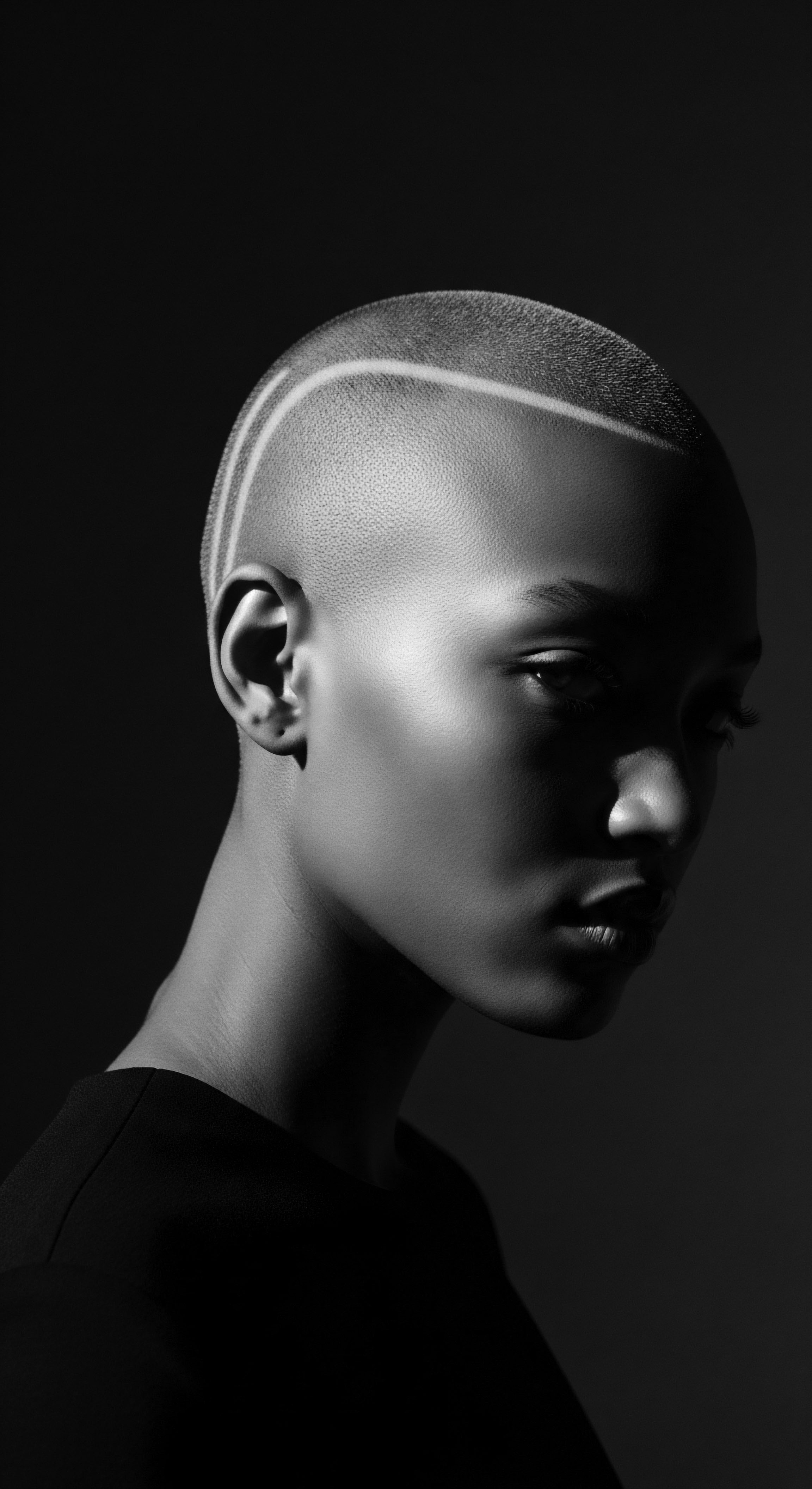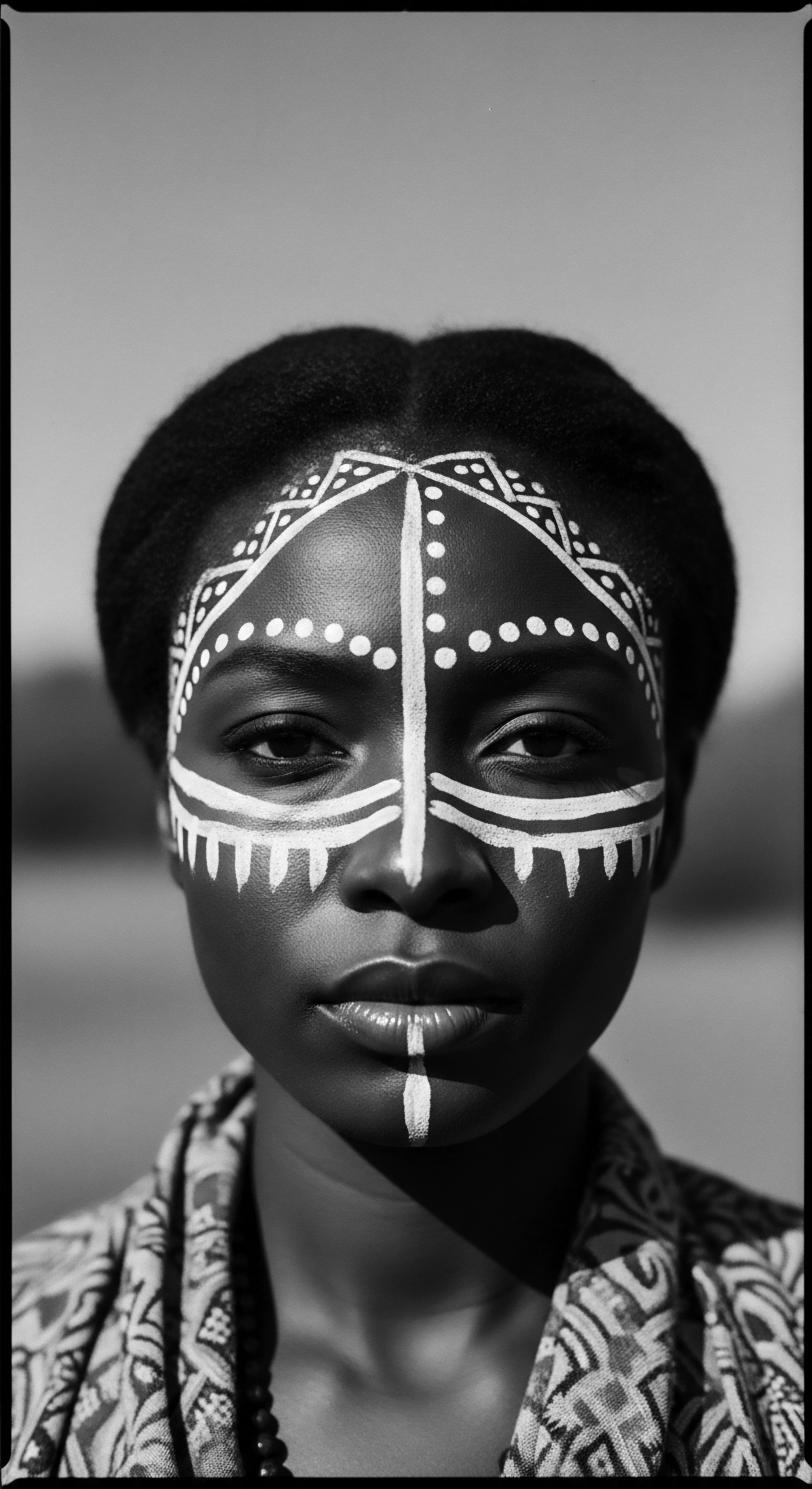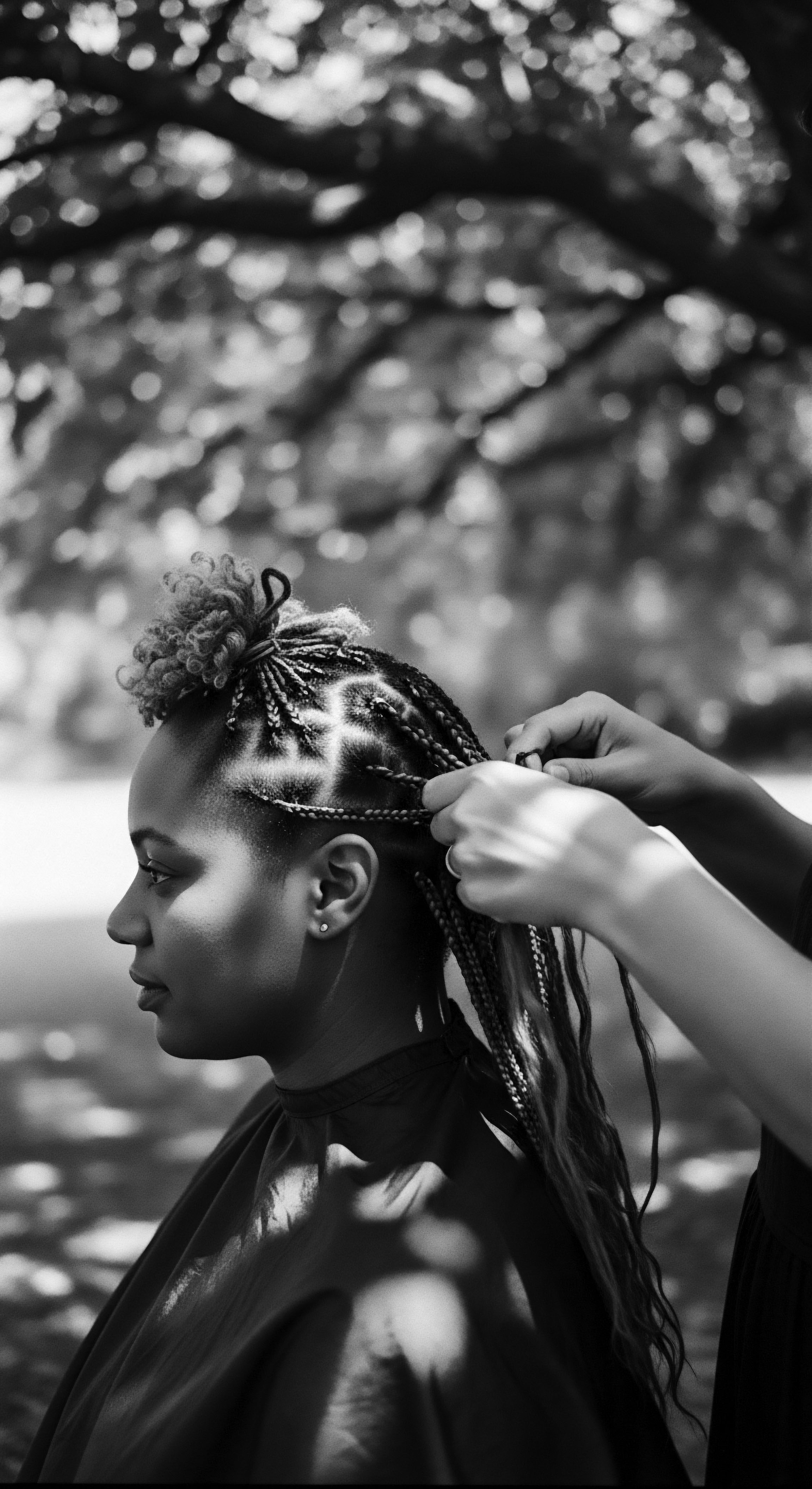
Fundamentals
The concept of “Medicinal Roots” extends beyond the simple biological definition of a plant’s subterranean anchors; it represents a profound understanding, a deep-seated comprehension, and a traditional interpretation of nature’s inherent power to nurture and restore. It speaks to the ancient wisdom held within the very foundation of botanical life, a wisdom long recognized and respectfully utilized across generations, particularly within communities whose heritage is intimately bound to the earth’s bounty. For textured hair, this connection is especially vivid, as historical practices often drew directly from roots, rhizomes, and other subterranean parts of plants for their restorative capabilities. This fundamental understanding is an echo from the source, a primal recognition of life-giving force.
Across Black and mixed-race hair traditions, the term “Medicinal Roots” embodies the elemental biology of specific plants and the ancestral knowledge systems that discerned their therapeutic properties. It encompasses the intricate networks of underground stems, tubers, and true roots that were, and continue to be, valued for their concentrated compounds. These parts frequently contain a spectrum of beneficial molecules – from nourishing starches and protective mucilages to potent antioxidants and antimicrobial agents.
Our ancestors, through generations of observation and experiential learning, developed sophisticated methods to extract and apply these natural endowments, recognizing their capacity to fortify strands, soothe scalps, and promote overall hair vitality. The fundamental explication of Medicinal Roots for hair care thus begins with this intertwined appreciation of nature’s design and human ingenuity.
Medicinal Roots embody nature’s inherent power and ancestral wisdom, offering restorative properties especially vital for textured hair care traditions.

The Earth’s Bounty for Our Strands
For centuries, the earth’s embrace has yielded remedies that speak directly to the needs of textured hair. Consider the humble root, often hidden from plain sight, yet a reservoir of life-sustaining properties. These botanical treasures were not merely ingredients; they were components of a living pharmacy, accessible and understood by those who lived in harmony with their environment.
The knowledge of which roots offered sustenance, which provided healing, and which imparted strength was a treasured inheritance, passed along not through formal texts, but through the cadence of daily life, the shared ritual of hair preparation, and the communal experience of care. This rich practice is foundational to comprehending the significance of Medicinal Roots.
The designation of a plant as possessing “medicinal roots” arises from its ability to offer therapeutic benefits, often specifically targeting the scalp and hair follicles. Indigenous communities throughout Africa and the diaspora learned to identify, harvest, and process these roots with precision. They understood that certain roots could stimulate growth, alleviate dryness, or protect against environmental stressors. This wasn’t merely about finding a temporary fix; it concerned fostering long-term resilience and maintaining the health of hair as a reflection of overall well-being.
The ancestral approach to hair care celebrated the natural state of textured hair, recognizing its unique structure and inherent beauty. Preparations involving plant roots often aimed to work in concert with the hair’s natural inclinations, rather than against them. This deep appreciation for the hair’s elemental form is a hallmark of the heritage-focused understanding of Medicinal Roots, setting a timeless precedent for authentic care.

Whispers of Ancient Care
The rituals surrounding hair care in ancestral communities were steeped in reverence for the natural world. Gathering roots, processing them into powders or decoctions, and applying them to the hair and scalp were not solely functional tasks. They were acts of connection, moments of quiet reflection, and affirmations of cultural identity.
These practices, the very essence of traditional hair care, served as a conduit for intergenerational bonding and the transmission of valuable knowledge. The preparation of hair treatments from Medicinal Roots was often a communal endeavor, a time for stories, songs, and the sharing of wisdom.
The meaning of “Medicinal Roots” in these contexts extends beyond the plant itself to the practices, the hands that prepared them, and the communal spirit in which they were applied. The care rituals created a sacred space, fostering a sense of belonging and continuity with those who came before. This heritage-rich approach reminds us that true wellness for textured hair is not simply about chemical compounds, but about the soulful connection to practices that honor history and self.
The knowledge inherent in these practices also served as a resilient form of self-preservation. When faced with oppression, these ancestral practices, often involving the use of local flora, became quiet acts of defiance, maintaining health and cultural identity in challenging circumstances. The legacy of these whispered traditions, built upon the bedrock of Medicinal Roots, remains an enduring testament to the strength and adaptability of Black and mixed-race communities.
- Aloe Vera (Aloe Barbadensis Miller) ❉ Often employed for its soothing mucilage, it provides moisture and alleviates scalp irritation, a practice deeply rooted in diverse healing traditions.
- Shea Butter (Vitellaria Paradoxa) ❉ Derived from the nut of the shea tree, its nourishing fats were used to condition hair, protect against dryness, and impart a healthy luster.
- Coconut Oil (Cocos Nucifera) ❉ A staple in many coastal communities, it offers deep conditioning and a protective barrier against environmental damage, a cherished element of ancestral hair routines.
This initial exploration into the fundamentals of Medicinal Roots underscores their significance ❉ they are not just botanical components, but cultural anchors, embodying a heritage of care and resilience.

Intermediate
Moving beyond an introductory comprehension, the intermediate interpretation of “Medicinal Roots” for textured hair delves into the intricate relationship between ethnobotanical wisdom and the unique biological structure of coily, kinky, and wavy strands. This deeper understanding reveals how ancestral practices, once viewed through a lens of folk remedy, often align with sophisticated biomechanical and biochemical principles. It is a continuous thread, connecting intuitive generational practices with the emerging insights of contemporary scientific inquiry, illuminating the ‘why’ behind enduring traditions of care. The inherent meaning of Medicinal Roots gains layers of significance as we appreciate the profound knowledge embedded in these historical applications.
The meaning expands to encompass the notion that the very structure of textured hair – its helical twists, its propensity for dryness due to the open cuticles, and its vulnerability to breakage at points of curvature – made it a particular focus for ancestral botanical intervention. Medicinal Roots, in this context, refers to the carefully selected plant materials that directly addressed these intrinsic characteristics. The traditional preparation methods, such as slow decoctions or infusions, were not arbitrary; they were often the most effective ways to extract the water-soluble compounds, minerals, and vitamins that could provide deep hydration, reinforce the hair shaft, or balance scalp micro-environments. This level of discernment, born of prolonged observation and inherited expertise, forms the core of an intermediate appreciation for these roots.

The Alchemy of Ancestral Preparations
The methods by which ancestral communities transformed raw botanical material into potent hair elixirs represent a form of practical alchemy. This historical process, far from being simplistic, involved a nuanced understanding of solubility, heat application, and the synergy of various plant components. Consider the preparation of a hair rinse from dried roots, a common practice across many cultures.
Boiling the roots at a low simmer for extended periods allowed for the gradual release of beneficial compounds, creating a decoction rich in saponins for gentle cleansing or tannins for scalp toning. These were not merely concoctions; they were carefully formulated remedies, designed to elicit specific therapeutic responses from the hair and scalp.
In various African and Afro-diasporic contexts, specific roots or root-derived products were employed with intentionality for hair health. For instance, the use of certain plant extracts rich in mucilage, such as from the marshmallow root or slippery elm bark (though technically bark, often used similarly to roots for their slimy consistency), provided a natural slip that aided detangling and reduced breakage for tightly coiled textures. This was an empirical application of botanical science, generations before modern chemistry could isolate and name the active ingredients. The deep understanding of Medicinal Roots speaks to this insightful, hands-on engagement with nature.
Ancestral hair care practices, utilizing Medicinal Roots through careful preparation, demonstrate a sophisticated understanding of plant properties that echoes modern scientific principles.

Hair as a Sacred Thread of Identity
Beyond their physiological benefits, Medicinal Roots in hair care played a profound role in shaping and preserving identity within Black and mixed-race communities. Hair, with its deep cultural and spiritual importance in many African societies, became a canvas for storytelling, status, and resistance. When slave traders brutally shaved the heads of captured Africans, it was a deliberate act to strip away their identity, disconnect them from their heritage, and sever their ties to ancestral practices.
However, the resilience of spirit endured. Enslaved people, against overwhelming odds, found ways to reclaim their hair’s significance using whatever natural resources were available to them, including makeshift remedies from local flora.
This defiance manifested in the ingenuity of hair care. Stories passed down through generations tell of enslaved individuals using cornmeal, kerosene, bacon grease, or butter as substitutes for traditional African oils and cleansers, all to maintain their hair, which was intrinsically tied to their self-worth and connection to their lineage. The very act of caring for one’s hair, even with improvised ingredients, became an act of cultural preservation.
The “roots” here are not just botanical but represent the enduring cultural and psychological roots of a people. The hair, meticulously tended, became a visual declaration of identity, a symbol of continuity despite profound rupture.
The deep cultural and historical significance of hair, often nourished by the remedies derived from Medicinal Roots, highlights its role as a living archive. Each braid, each coil, each strand, holds the echoes of resistance and the whispers of resilience. It is a testament to the unyielding spirit of those who, through the tender thread of hair care, sustained their heritage against the currents of oppression. This intricate dance between botanical resources and cultural meaning gives “Medicinal Roots” an even deeper, more resonant sense.
| Root/Plant Part Jatamansi (Nardostachys jatamansi) |
| Traditional Preparation Method Rhizomes prepared as oil infusions or powders |
| Observed Hair/Scalp Benefit Promotes hair growth, calms scalp ailments, imparts shine. |
| Root/Plant Part Shikakai (Acacia concinna) |
| Traditional Preparation Method Pods dried and powdered, used as a natural cleanser/conditioner |
| Observed Hair/Scalp Benefit Gentle cleansing, maintains pH, strengthens roots, reduces dryness. |
| Root/Plant Part Yucca Root (Yucca schidigera) |
| Traditional Preparation Method Macerated root used to create a lathering wash |
| Observed Hair/Scalp Benefit Natural cleanser, soothes scalp, adds volume without stripping natural oils. |
| Root/Plant Part Burdock Root (Arctium lappa) |
| Traditional Preparation Method Decoctions and oil infusions from dried root |
| Observed Hair/Scalp Benefit Improves scalp health, addresses dandruff, strengthens hair follicles. |
| Root/Plant Part These ancestral preparations, derived from Medicinal Roots, underscore an intuitive ethnobotanical wisdom that continues to resonate in contemporary hair wellness. |

Academic
At the academic stratum, the “Medicinal Roots” takes on a multifaceted elucidation, transcending a mere botanical or folk connotation to signify a nexus of ethno-pharmaceutical history, socio-cultural anthropology, and the emerging science of adaptive human biological interactions with their environments. It is an exploration, a detailed delineation, of how specific plant organ systems – the roots, rhizomes, and tubers – were not only empiric sources of therapeutic agents for hair and scalp conditions but also profound repositories of ancestral knowledge, cultural resilience, and identity construction, particularly within the Black and mixed-race diasporic experience. This complex interpretation acknowledges the scientific validity often implicit in age-old practices, while simultaneously honoring the deep human significance of such traditions. The explication of Medicinal Roots at this level demands a rigorous, evidence-based approach, demonstrating the symbiotic relationship between human populations and the flora that sustained their well-being.
The meaning of “Medicinal Roots” from an academic vantage point extends to the critical role these botanical components played in mitigating the profound health disparities and cultural assaults experienced by marginalized communities. Their importance is underscored by the fact that for many, particularly during periods of enslavement and colonialism, these natural remedies were the primary, if not sole, means of preserving health and maintaining a connection to a lost heritage. This designation encompasses the sophisticated, albeit informally transmitted, systems of botanical classification, harvesting techniques, and preparation methodologies developed by these communities.
It is a testament to their profound observation skills and their deep comprehension of phytochemical properties, long before formal scientific methodologies could quantify such knowledge. The substance of Medicinal Roots, then, is not merely about chemical compounds, but about the enduring human spirit and intellect applied to survival and flourishing.

Ethno-Botanical Foundations and Sociocultural Resonance
The study of ethno-botany, particularly in Afro-descendant communities, reveals a remarkable preservation and adaptation of traditional plant knowledge that directly informs our comprehension of Medicinal Roots. Across the Atlantic, enslaved Africans carried with them not only their memories and traditions but also, implicitly or explicitly, the botanical wisdom accumulated over millennia. This knowledge, concerning the therapeutic and cosmetic applications of various plants, was critical for survival and cultural continuity in new, often hostile, environments. Upon arrival in the Americas, a process of botanical syncretism occurred, where familiar African plants were sought out or, in their absence, analogous local flora were identified and integrated into existing practices.
This adaptation was not accidental; it was a deliberate and intelligent application of inherited understanding. Scholars have documented this phenomenon extensively, demonstrating how communities in the Caribbean, Brazil, and the American South continued to apply West African ethno-medical principles to new plant species. For instance, the traditional uses of plant roots like the wild senna (Senna alata) or sarsaparilla (Smilax regelii) in Caribbean herbal traditions reflect an enduring botanical lineage, their properties for health and hair care being analogous to plants used in Africa. The persistence of these practices, despite the brutal disruption of forced migration, speaks volumes about their efficacy and cultural salience.
Medicinal Roots represent a resilient tapestry of ethno-botanical knowledge, adapted and preserved by Afro-descendant communities, linking ancestral wisdom with new environments.
The resonance of Medicinal Roots is not confined to biological action; it extends to the very psychology of identity and self-care. In societies that often devalued and denigrated textured hair, the act of tending to it with ancestral remedies became an affirmation of inherent beauty and a rejection of imposed standards. In Brazil, for example, where Eurocentric beauty ideals have historically promoted straight, light hair, the embrace of natural, textured hair, often nourished by traditional botanical preparations, became a powerful symbol of racial affirmation and identity. This demonstrates how the simple act of hair care, rooted in the use of Medicinal Roots, can carry profound socio-political weight.

Resilience Through Botanical Kinship ❉ A Historical Case Study
A particularly poignant example illuminating the power of Medicinal Roots within textured hair heritage emerges from the resilience of enslaved African women in the Antebellum South. Stripped of their cultural symbols and traditional implements, these women ingeniously adapted their ancestral hair care knowledge to their new, brutal realities, transforming the very act of hair maintenance into an act of resistance and cultural preservation. Among the profound acts of self-determination, documented in resources like the Federal Writers’ Project Slave Narratives, was the clandestine use of local flora to address health and beauty needs. While much scholarly attention has focused on medicinal plants for internal ailments or reproductive autonomy, the application of similar ingenuity to hair care presents a compelling narrative of enduring self-respect and cultural continuity.
Consider the resourcefulness in utilizing readily available, albeit unconventional, substances for hair conditioning and scalp treatment. While traditional African oils and cleansers were unavailable, enslaved women would turn to ingredients like bacon grease or butter for conditioning, recognizing their emollient properties. More significantly, for cleansing and stimulating the scalp, they reportedly concocted shampoos from cornmeal and even kerosene. While kerosene is clearly not a traditional botanical root, its documented use highlights the desperate circumstances and the drive to maintain hair health.
Crucially, this reflects a deeper principle of “Medicinal Roots” ❉ not just the specific plant, but the spirit of finding and applying whatever natural resource served a vital purpose. The very act of attempting to sustain hair health, however crude the means, was an act of defiance against the systematic dehumanization they faced.
The broader context of their medicinal practices reveals a sophisticated ethno-medical system that merged African spiritualism with an acute understanding of American flora. As noted by Herbert Covey in his work, enslaved African Americans developed an extensive pharmacopoeia, relying on plants for healing, protection, and maintaining cultural integrity. The oral accounts from the WPA narratives reveal how elderly African American women often held positions of immense medical wisdom within their communities, serving as healers and midwives.
These women, the bearers of ancestral knowledge, would undoubtedly have extended their expertise to hair and scalp health, understanding its connection to overall well-being and spiritual strength. The continuity of these practices, even under duress, solidifies the notion of Medicinal Roots as a dynamic, living heritage.
The sheer fact that, despite the attempts to erase their culture, enslaved people managed to preserve and adapt knowledge of plant-based care speaks to the deep cultural value placed on hair. Braiding patterns, for instance, were sometimes used to map escape routes, encoding messages of freedom within intricate hairstyles, This interwoven history of practical botanical application and symbolic cultural expression elevates the meaning of “Medicinal Roots” beyond a mere scientific description; it becomes a powerful statement of human tenacity and the enduring power of heritage. This historical example reveals how deeply intertwined the physical act of hair care was with the spiritual and cultural survival of a people, rooted in a profound, albeit sometimes improvised, connection to nature’s healing elements.

Contemporary Scientific Affirmations
Modern scientific inquiry has begun to validate many of the traditional claims associated with Medicinal Roots. Research into the phytochemical profiles of plants historically used for hair care often reveals compounds with anti-inflammatory, antimicrobial, antioxidant, and growth-stimulating properties. For instance, studies on various African plants traditionally used for hair treatment show high concentrations of compounds with potential anti-diabetic effects, suggesting a systemic connection between metabolic health and hair vitality, a holistic insight that ancient practitioners may have intuitively grasped.
Moreover, the growing body of literature on hair biology and scalp microbiome health confirms the importance of a balanced environment for optimal hair growth. Many traditional Medicinal Root preparations, through their cleansing and toning actions, likely contributed to this equilibrium, thus affirming the wisdom of ancestral practices. The rigorous examination of these traditional remedies continues to unveil how modern science can learn from, and expand upon, the knowledge held within these enduring heritage practices.
- Ricinus Communis (Castor Oil) ❉ Widely used for its moisturizing and hair-growth stimulating properties, particularly for thickening strands and nurturing the scalp.
- Trigonella Foenum-Graecum (Fenugreek) ❉ Utilized for promoting hair growth and strengthening hair shafts, with studies affirming its efficacy.
- Garcinia Kola and Allium Sativum ❉ Aqueous extracts of these seeds have shown promise in reducing hair shedding and breakage in Afro-textured hair.
- Bacopa Monnieri (Brahmi) ❉ An important Ayurvedic herb, its leaves and stems are traditionally collected to invigorate hair follicles and promote overall hair health.
| Region/Community West Africa (General) |
| Example Medicinal Roots/Plants Garcinia Kola, Allium Sativum (Garlic) |
| Traditional Application/Benefit Used in aqueous extracts to reduce hair shedding and breakage, reflecting an understanding of scalp vitality. |
| Region/Community Caribbean Islands |
| Example Medicinal Roots/Plants Sea Moss (various species of algae), Wild Senna (Senna alata) |
| Traditional Application/Benefit Sea moss applied topically for strength and shine; wild senna for various skin and hair ailments, demonstrating adaptation of African ethnobotanical knowledge. |
| Region/Community Brazilian Afro-Diasporic Communities |
| Example Medicinal Roots/Plants Andiroba (Carapa guianensis), Copaiba (Copaifera spp.) |
| Traditional Application/Benefit Oils from these Amazonian plants used for anti-inflammatory effects, regulating sebaceous activity, and promoting scalp health, linking indigenous and Afro-Brazilian practices. |
| Region/Community American Antebellum South (Enslaved) |
| Example Medicinal Roots/Plants Cornmeal, various local plants (e.g. mucilaginous roots, though specific species are harder to trace due to oppressive context) |
| Traditional Application/Benefit Ingenious use of available materials for cleansing and conditioning, an act of preserving hair health and cultural identity amidst systemic dehumanization. |
| Region/Community These examples highlight the adaptive ingenuity and enduring knowledge of Medicinal Roots within diverse Afro-diasporic contexts, showcasing resilience and cultural continuity. |

Reflection on the Heritage of Medicinal Roots
As we draw this meditation to a close, the enduring nature and evolving significance of Medicinal Roots for textured hair communities continue to beckon contemplation. The journey from elemental biology to profound cultural expression reveals a wisdom that transcends time and geography. It is a compelling reminder that the care of our hair, particularly for those with Black and mixed-race heritage, is never merely a cosmetic endeavor. It is a living, breathing archive of ancestral ingenuity, a testament to resilience, and a continuous dialogue with the earth’s timeless offerings.
The legacy of Medicinal Roots, whether in the quiet strength of a botanical extract or the vibrant narrative of cultural survival, asks us to look beyond the surface. It invites us to honor the hands that tilled the soil, the minds that discerned the properties of each leaf and root, and the spirits that found solace and empowerment in tending to their crowns. In every carefully chosen ingredient, in every mindful application, there exists an echo of those who came before, affirming a profound connection to the earth and to one another.
The “Soul of a Strand” ethos finds its deepest resonance in this heritage. Each coil and curl is not just a physical manifestation; it is a repository of history, a vessel for ancestral memory, and a promise for the future. Understanding and re-engaging with Medicinal Roots allows us to partake in a tradition of holistic wellness that nourishes not only the hair itself but also the spirit and identity intrinsically tied to it. This enduring connection serves as a beacon, guiding us toward a future of hair care that is as authentic as it is effective, deeply rooted in the wisdom of the past.

References
- Byrd, Ayana D. and Lori L. Tharps. Hair Story ❉ Untangling the Roots of Black Hair in America. St. Martin’s Press, 2001.
- Carney, Judith A. “African Traditional Plant Knowledge in the Circum-Caribbean Region.” Journal of Ethnobiology, vol. 23, no. 2, 2003, pp. 167-183.
- Covey, Herbert C. African American Slave Medicine ❉ Herbal and Non-Herbal Treatments. Rowman & Littlefield Publishers, Inc. 2007.
- Fett, Sharla M. Working Cures ❉ Healing, Health, and Power on Southern Slave Plantations. University of North Carolina Press, 2002.
- ISROSET. “Evaluation of Aqueous Seed Extracts of Garcinia Kola and Allium Sativum in Hair Loss Reduction.” International Journal of Scientific Research in Biological Sciences, vol. 11, no. 3, 2024, pp. 147-151.
- Omolewu, Oluwaseun O. and Olaniyi P. Ibikunle. “Ethnobotanical Studies of Folklore Phytocosmetics of South West Nigeria.” Journal of Ethnopharmacology, vol. 156, 2014, pp. 248-256.
- Rthvi. “Exploring Ancient Hair Care Rituals ❉ Timeless Practices for Modern Hair Wellness.” Rthvi.com, 30 Oct. 2024.
- SAS Publishers. “Plants Use in the Care and Management of Afro-Textured Hair ❉ A Survey of 100 Participants.” Scholars Academic Journal of Biosciences, vol. 11, no. 11, 2023, pp. 147-151.
- Shim, Synia. “Our Hair ROOTS ❉ Incorporating Our Black Family Hair Traditions and Routines as a Coping Technique to Increase Positive Mental Health.” PsychoHairapy.com, 18 Dec. 2024.
- Singh, Pradumn Kumar, et al. “Role of Medicinal Plants in Management of Various Hair Related Troubles ❉ An Overview.” International Journal of Novel Research and Development, vol. 7, no. 10, 2022, pp. 763-770.
